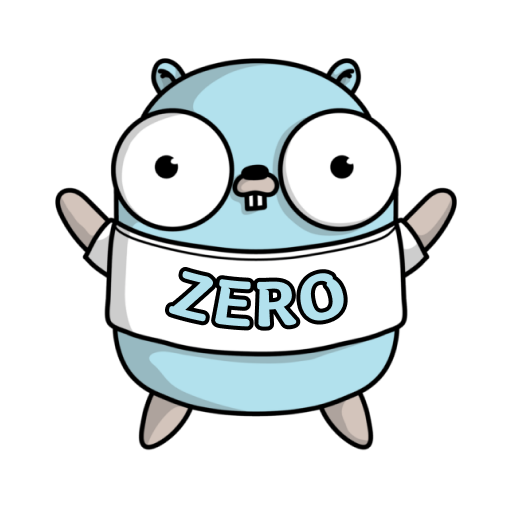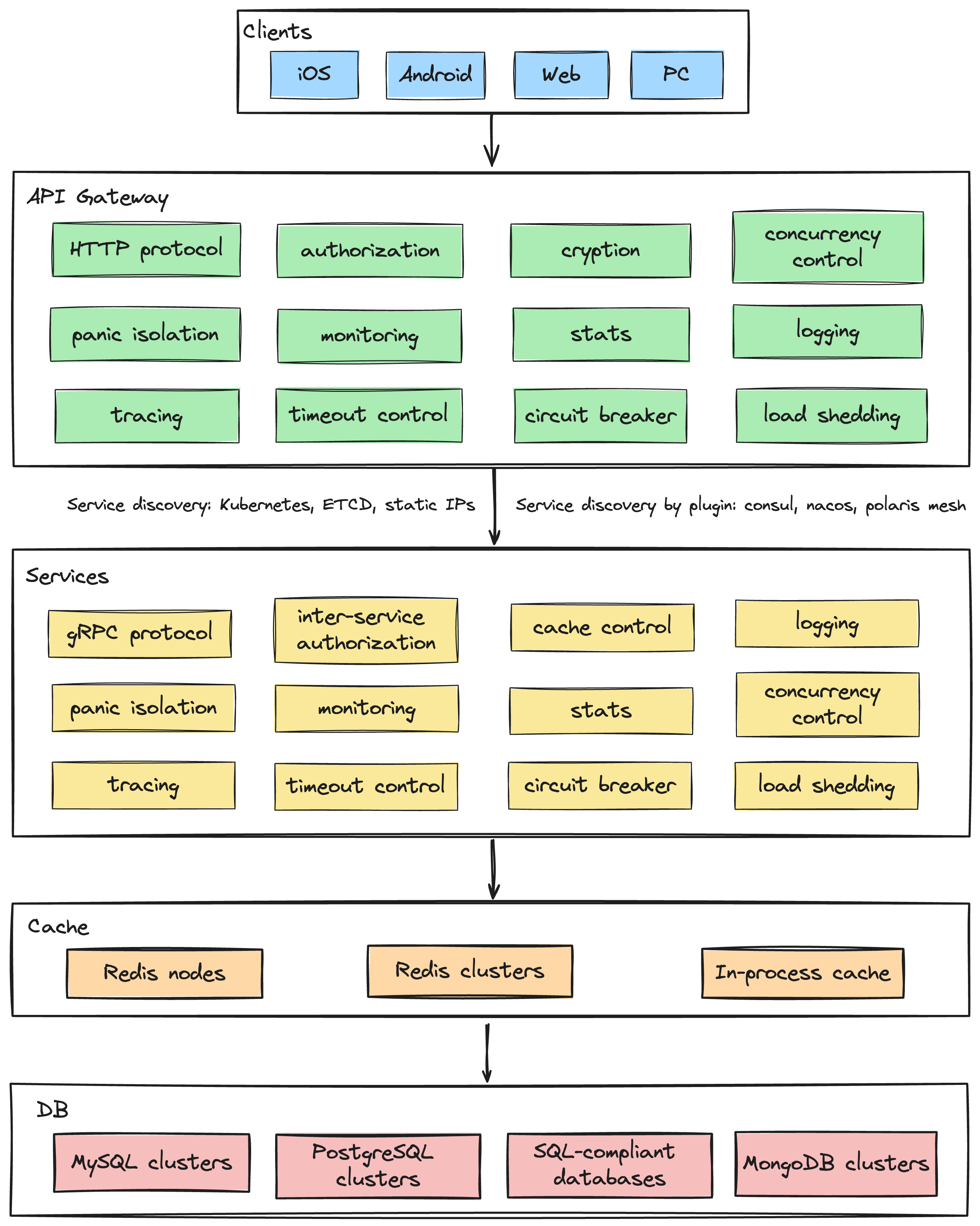Go-zero

Detalles del producto
Casos de Uso
Hablar con el vendedor
Planes de soporte
Actualmente no hay planes OSS disponibles
Si eres proveedor o colaborador del repositorio, puedes comenzar a agregar tu plan OSS.
Añadir un plan OSSContáctenos www.piecex.com/contacts si está buscando un plan para este código abierto. Le ayudaremos a ponerse en contacto con proveedores profesionales.
Detalles del producto
go-zero

go-zero is a web and rpc framework with lots of builtin engineering practices. It’s born to ensure the stability of the busy services with resilience design and has been serving sites with tens of millions of users for years.
🤷 What is go-zero?
English | 简体中文
go-zero (listed in CNCF Landscape: https://landscape.cncf.io/?selected=go-zero) is a web and rpc framework with lots of builtin engineering practices. It’s born to ensure the stability of the busy services with resilience design and has been serving sites with tens of millions of users for years.
go-zero contains simple API description syntax and code generation tool called goctl. You can generate Go, iOS, Android, Kotlin, Dart, TypeScript, JavaScript from .api files with goctl.
Advantages of go-zero:
- Improves the stability of the services with tens of millions of daily active users
- Builtin chained timeout control, concurrency control, rate limit, adaptive circuit breaker, adaptive load shedding, even no configuration needed
- Builtin middlewares also can be integrated into your frameworks
- Simple API syntax, one command to generate a couple of different languages
- Auto validate the request parameters from clients
- Plenty of builtin microservice management and concurrent toolkits

Backgrounds of go-zero
In early 2018, we embarked on a transformative journey to redesign our system, transitioning from a monolithic architecture built with Java and MongoDB to a microservices architecture. After careful research and comparison, we made a deliberate choice to:
-
Go Beyond with Golang
- Great performance
- Simple syntax
- Proven engineering efficiency
- Extreme deployment experience
- Less server resource consumption
-
Self-Design Our Microservice Architecture
- Microservice architecture facilitates the creation of scalable, flexible, and maintainable software systems with independent, reusable components.
- Easy to locate the problems within microservices.
- Easy to extend the features by adding or modifying specific microservices without impacting the entire system.
Design considerations on go-zero
By designing the microservice architecture, we expected to ensure stability, as well as productivity. And from just the beginning, we have the following design principles:
- Keep it simple
- High availability
- Stable on high concurrency
- Easy to extend
- Resilience design, failure-oriented programming
- Try best to be friendly to the business logic development, encapsulate the complexity
- One thing, one way
After almost half a year, we finished the transfer from a monolithic system to microservice system and deployed on August 2018. The new system guaranteed business growth and system stability.
The implementation and features of go-zero
go-zero is a web and rpc framework that integrates lots of engineering practices. The features are mainly listed below:
- Powerful tool included, less code to write
- Simple interfaces
- Fully compatible with net/http
- Middlewares are supported, easy to extend
- High performance
- Failure-oriented programming, resilience design
- Builtin service discovery, load balancing
- Builtin concurrency control, adaptive circuit breaker, adaptive load shedding, auto-trigger, auto recover
- Auto validation of API request parameters
- Chained timeout control
- Auto management of data caching
- Call tracing, metrics, and monitoring
- High concurrency protected
As below, go-zero protects the system with a couple of layers and mechanisms:

The simplified architecture that we use with go-zero

Installation
Run the following command under your project:
go get -u github.com/zeromicro/go-zeroQuick Start
-
Full examples can be checked out from below:
-
Install goctl
goctlcan be read asgo control.goctlmeans not to be controlled by code, instead, we control it. The insidegois notgolang. At the very beginning, I was expecting it to help us improve productivity, and make our lives easier.# for Go go install github.com/zeromicro/go-zero/tools/goctl@latest # For Mac brew install goctl # docker for all platforms docker pull kevinwan/goctl # run goctl docker run --rm -it -v `pwd`:/app kevinwan/goctl --helpmake sure goctl is executable and in your $PATH.
-
Create the API file, like greet.api, you can install the plugin of goctl in vs code, api syntax is supported.
type ( Request { Name string `path:"name,options=[you,me]"` // parameters are auto validated } Response { Message string `json:"message"` } ) service greet-api { @handler GreetHandler get /greet/from/:name(Request) returns (Response) }the .api files also can be generated by goctl, like below:
goctl api -o greet.api -
Generate the go server-side code
goctl api go -api greet.api -dir greetthe generated files look like:
├── greet │ ├── etc │ │ └── greet-api.yaml // configuration file │ ├── greet.go // main file │ └── internal │ ├── config │ │ └── config.go // configuration definition │ ├── handler │ │ ├── greethandler.go // get/put/post/delete routes are defined here │ │ └── routes.go // routes list │ ├── logic │ │ └── greetlogic.go // request logic can be written here │ ├── svc │ │ └── servicecontext.go // service context, mysql/redis can be passed in here │ └── types │ └── types.go // request/response defined here └── greet.api // api description filethe generated code can be run directly:
cd greet go mod tidy go run greet.go -f etc/greet-api.yamlby default, it’s listening on port 8888, while it can be changed in the configuration file.
you can check it by curl:
curl -i http://localhost:8888/greet/from/youthe response looks like below:
HTTP/1.1 200 OK Date: Sun, 30 Aug 2020 15:32:35 GMT Content-Length: 0 -
Write the business logic code
- the dependencies can be passed into the logic within servicecontext.go, like mysql, redis, etc.
- add the logic code in a logic package according to .api file
-
Generate code like Java, TypeScript, Dart, JavaScript, etc. just from the api file
goctl api java -api greet.api -dir greet goctl api dart -api greet.api -dir greet ...
Benchmark

Documents
- Documents
- Rapid development of microservice systems
- Rapid development of microservice systems - multiple RPCs
- Examples
Chat group
Join the chat via https://discord.gg/4JQvC5A4Fe
Cloud Native Landscape


go-zero enlisted in the CNCF Cloud Native Landscape.
Give a Star! ⭐
If you like this project or are using it to learn or start your own solution, give it a star to get updates on new releases. Your support matters!












